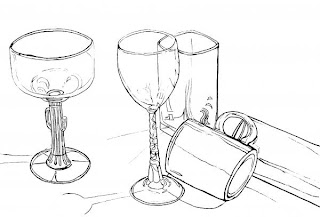Everything in this image goes out from the center, giving it a radial appearance. This creates balance and untiy for the picture.
Monday, April 25, 2011
25. Asymmetrical Balance
Although this image is not identical on both sides, the weight is distrubuted evenly in an eye-pleasing way. The queen piece equals the balance of the four pawns on the right. This is how asymmetrical balance works.
24. Symmetrical Balance
Both halves of the image are symmetrical (split vertically). There is also a reflected image in the pool.
23. Unity with Variety
Unity with variety is simply a unified image that is composed of similar but not identical shapes and designs. So, although they vary, they also maintain a unifying element. All of the masks and arms in the image above are different yet are commonly related because they are the same objects.
22. Unity through Continuity
21. Unity through Continuation
The viewers eye is carried smoothly from one element to the next. Our eye naturally wants to follow the staircase curve as it goes downward.
20. Unity through Repetition
This image is an example of unity through repetition because the "goose" element is repeated throughout the work unifying geese as the entire subject.
18. Visual Texture
In visual texture, the texture is solely visual.. as in not a real touchable texture. The texture is created in this painting by using smooth lines carefully blended.
17. Tactile Texture
Tactile texture can actually be felt with your hands. The paint in this painting is so thick that it creates its own shadows and if you touched the surface you could feel the roughness.
16. Value as Emphasis
High dark and light contrast catches attention and creates instant emphasis that draws our eyes in. The strong darks and lights in this painting add to the dramatic mood and also increase emphasis on the figures.
Wednesday, April 13, 2011
13. Rectilinear Shapes
Rectilinear shapes are non-organic shaped objects. They typically have harsh edges unassociated with living things - which follow a more rounded smoother structure. Architecture is an example of rectilinear shapes.
12. Non-Objective Shapes
11. Abstraction
Abstraction is the simplification of natural shapes (organic) to their essential, basic character. In this painting, figures are headless but there is an illusion that the circles in the background are their heads. The figures in the background also have circles for heads. Although this is not how an actual human looks, we can still tell what it is through its basic shapes.
10. Idealism
Idealism is the strive for perfection in the human body and also in nature. In this statue by Michelangelo, the face is perfectly proportioned and is an idealistic portrayal of how people want to look.
9. Distortion
8. Naturalism
6. Line as Value
5. Gesture line
A gesture line is a quick sketch of any object, although typically done of anatomical features and humans. It gives the basic outline of the figure while still maintaining a sense of depth and form. Gestures can be simple or complex. The main idea is to grasp the proportions and form of the figure so that you can further detail and intensify your piece. Gestures also show movement of the body and how changes in position change the size and location of other body parts.
4. Contour Line
Contour lines provide just an outline edge of the actual image. There is no depth or demensionality to the picture if left alone. Contours do provide a separation from the background and other objects presented in the scene. It is mainly an outline of the basic idea.
3. Line as Emotion
the arrangement of lines can convey different emotions. Jagged lines, for example, give a feeling of edge and potential hazard. It is uncertain looking and appears painful to touch. A smooth, flowing line would be calming. We can use these different techniques to convey messages through our artwork.
1. Line as Shape
Line can be used to create simple and complex shapes. In this example, a series of 10 identical lines are placed to create a "star" shape. So, the previously simple, basic line, becomes a more complex and interesting image.
Subscribe to:
Posts (Atom)























